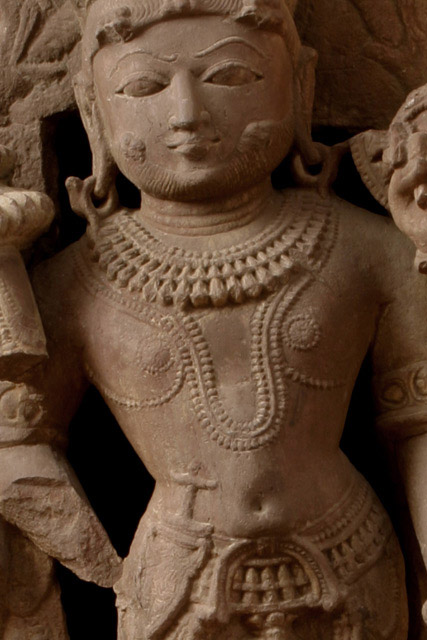

|
Central India, Madhya Pradesh Medieval Period, 11th century Sandstone 44 x 19 inches (111.8 x 48.3 cm) |

Detail: close-up view Virabhadra, the powerful warrior created from the torn hair of Shiva, is envisioned in this large, high-quality, eleventh-century sculpture from Madhya Pradesh. The fighter was created after Shiva�s wife, Sati, was not invited to a great sacrifice given by her father, Daksha. Humiliated, Sati went to the ceremony and threw herself into the sacrificial fire. When Shiva heard of this tragedy, he tore out his hair and threw it on the ground. From his torn hair arose the warrior Virabhadra, who, along with his army, destroyed the sacrifice, decapitated Daksha, and sacrificed the head in fire. Vishnu then intervened and Shiva grafted the head of a goat to Daksha�s neck and restored him to life. The figure of Virabhadra sways in gentle tribhanga, creating subtle movement. The deity is adorned profusely with jewelry and the sacred cord hangs low between the legs. In keeping with his characteristic iconography, Virabhadra wears sandals on his feet and has a dog at his side. A serpent hood crowns the manifestation, which also attests to the Shaivite subject. He carries a mace, a shield, and a sheathed dagger at his side. A long garland hangs to his ankles. A severed head was probably held in the primary left hand over the dog, and a sword in the broken right hand. This is possibly the largest, most significant stone carving of Virabhadra known from this period and region. Virabhadra is usually represented in the form of small devotional bronzes, or in a subsidiary role in stone relief carvings. The image is also of great significance because it is from Madhya Pradesh. Virabhadra seems to have generally played a larger role in Shaivite worship in South India, as the main temples devoted to this warrior are located in Karnataka and Andhra Pradesh. Although there are no temples devoted specifically to Virabhadra in Madhya Pradesh, this particular sculpture indicates that the deity enjoyed a certain cult following. And, more importantly, it appears this Virabhadra cult had strong enough financial support to commission such a major representation of the deity. In summary, this stone carving of Virabhadra is of superb quality and is a large-sized sculpture from the Medieval Period. It exhibits the best qualities of sculpture from this period with its attention to how form interacts fluidly with its surrounding space rather than conforming to naturalistic limitations. The sculpture is also a rare and important representation of this Shaivite cult deity from Madhya Pradesh, rather than from the more common worship centers in South India. |
|
|